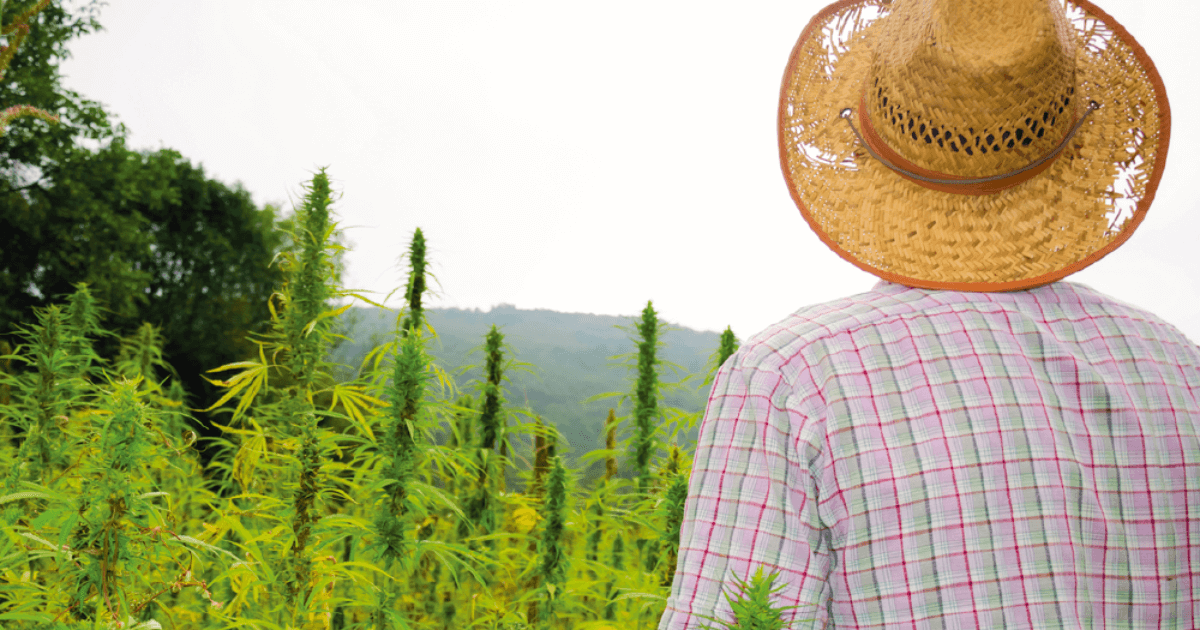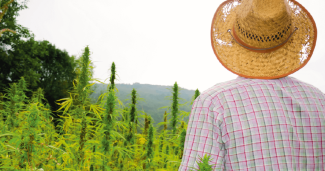The Myriad Health & Safety Risks for Cannabis Workers

[Editor’s Note: The fall issue of Streamline is arriving in mailboxes across the US. Here, we reprint the cover article on health risks for cannabis workers. This newest issue of our in-print quarterly publication also features articles on addressing Adverse Childhood Experiences (ACEs) among agricultural worker communities; a trio of articles on diabetes, including on mental health and diabetes, MCN’s Diabetes ECHO, and MCN’s updated diabetes comic book for Puerto Rican audiences; a Health Network case study; and an article on the new Health Network Portal. Read the entire issue on our Streamline archives page. We are looking for additional members to our Streamline external editorial board. Please contact Claire at cseda@migrantclinician.org for more information on this opportunity.]
In the remote forests of the far northwestern corner of California, dubbed the Emerald Triangle, the cannabis trimming season is underway. From September to December, migrant farmworkers from around the world cut the psychoactive flower buds from the cannabis plant for processing.
Cannabis in California is like no other agricultural product. The market has grown substantially since its legalization for recreational use in 2016. Market pressures and competition resulted in $5.3 billion in legal sales in 2022 -- 8% lower than sales in 2021, yet still indicative of an agricultural powerhouse. The health issues that arise for the workers who tend to and process the plants are different from other crops. “The fact that it’s an illegal commodity at the federal level changes the landscape” for the health and safety of cannabis farmworkers, suggested Marc Schenker, MD, MPH, a longtime researcher on farmworker health with the University of California, Davis, and a former member of Migrant Clinicians Network’s Board of Directors. Cannabis farmworkers contend with stigmatization, deeply remote locations, frequent utilization of firearms on-site for security, a vastly different farmworker profile, temporary and unconventional living conditions, physiological exposures, structural violence, race- and gender-based discrimination, and wage theft. Earlier this year, Dr. Schenker joined Xochitl Castañeda, PhD, Founding Director of Health Initiative of the Americas (HIA) at the School of Public Health, University of California, Berkeley and also a member of MCN’s Board of Directors, along with lead author Stella Beckman, PhD, MPH, and other authors, to publish a set of research articles based on interviews with cannabis workers, exploring these many issues that they confront. Here, we present some of the health concerns highlighted in their articles and in a recent interview with Drs. Schenker and Castañeda.
Dictionary of Terms:
Cannabis: Any part of the Cannabis sativa or C. indica plants
Marijuana: There are varying definitions of the word, leading researchers to prefer the clearer term “cannabis.” “Marijuana” is often used synonymously with the term “cannabis.” The term is also used to refer to the psychoactive parts of the Cannabis sativa or C. indica plants that contain high levels of THC, namely, the flower buds and leaves.
Cannabinoid: The chemical components found in cannabis. THC and CBD are the two primary cannabinoids. Data indicate that cannabinoids may help certain “rare forms” of epilepsy, reduce nausea in cancer patients, and reduce appetite loss and weight loss in patients with HIV/AIDS. There is some evidence it may help with chronic pain and multiple sclerosis symptoms. Read more on this National Institute of Health page: www.nccih.nih.gov/health/cannabis-marijuana-and-cannabinoids-what-you-need-to-know
THC: Tetrahydrocannabinol, the cannabinoid in cannabis that causes a “high.”
CBD: Cannabidiol, a cannabinoid in cannabis that has been used therapeutically, but without the altered mental state of THC.
Hemp: Cannabis sativa plants with very low levels of THC. These plants are federally legal.
Physiological concerns
Cannabis workers have unique dermatologic, respiratory, and ergonomic issues. Cannabis is an allergen, and farmworkers experience contact dermatitis or, in more severe cases, systemic response. Like other farmworkers, they are routinely exposed to pesticides and other chemicals used during the growing and processing stages, and they suffer from ergonomic challenges like stooping and bending and working with pruners and scissors. High dust levels and air contaminants like mold contribute to respiratory issues among many workers. Much of the product is processed into oils, which requires a high-pressure volatile extraction, which can also be dangerous for workers if improperly performed or ventilated.
Work limits and training
Workers who were interviewed reported working long hours – sometimes “13 hours a day for six to seven days a week, for three months,” Dr. Schenker noted – increasing the risk of physical injury and psychological stress. To prevent injury and preserve well-being, “you need a shorter workday, and you [shouldn’t] work seven days a week, and yet none of those controls exist,” he added. Further, workers are eager for increased hours to make more money, and many embody a viewpoint that their bodies can handle it. “Health and safety regulations should apply to these workers, like mandatory rest breaks and limits [on] the hours per day or days per week, and health and safety training,” Dr. Schenker emphasized. “None of our subjects reported getting any training in health and safety.”
Farmworker profile
“Ten years ago, [cannabis workers] tended to be more hippies, more Europeans. Now, there are waves of Latinos,” in addition to other ethnic groups, including Hmongs and Thais, noted Dr. Castañeda. With few training opportunities in place, it is unlikely that culturally and linguistically appropriate communications and accommodations are available, which may limit workers’ ability to communicate with supervisors, over issues such as health, safety, rights, and wages. It may also lead to misuse of tools and pesticides when communication on use and labeling is not in their preferred language.
Living conditions
Many workers live in their cars or in tents, unprotected from the elements. In the fall, large uncontrolled wildfires often bring smoke to the growing region, with most farmworkers not getting reprieve from smoke inhalation even at night after work. As climate change progresses, said Dr. Castañeda, this danger will occur more frequently. In the winter, workers lack heating, and inhale fumes from kerosene or propane heaters used in place of cleaner indoor heaters.
Firearms and concertina wire
More than half of cannabis cultivation is still conducted illegally despite legalization. Farms that are operating legally may still “work in the gray, or even in the black markets,” noted Dr. Castañeda. Coupled with its very high value, this explains some of the defense efforts that some farms undertake, which may increase injury risk for workers. It also instills fear in the workers, who may decline to speak up about workplace conditions or wage discrepancies.
Wage theft
Dr. Castañeda shared that workers take on the risk of the market, which may reduce or eliminate their wages. “If the owner doesn’t sell the crop at the price they thought because they are competing with others, the workers have to absorb [it],” explained Dr. Castañeda, a situation that the researchers found on some farms. If the owner sells at a higher price, however, those profits are not distributed to the workers. “What can they do? There are guns -- you are not paid,” she said. “When we asked, what is your biggest fear working in this industry? Two things: not being paid and being deported.”
Gender- and race-based discrimination
The fear of deportation emphasizes the immigration-status power dynamic that exists on farms. “There’s a lot of racial discrimination that has been documented in other parts of the country [that] also grow cannabis,” she said. “The owners are white – they live in the facilities, and the trimmers and other workers live in tents,” she added, by way of example. Dr. Castañeda also noted that facilities can be inappropriate or unsafe for women. As in many agricultural settings, women experience sexual harassment and/or feel unsafe in the environment. They additionally face challenges addressing their basic needs: “There is no running water, so they were saying, ‘I’m on my period. When am I going to take a real shower?’” she recounted.
Remote locations
Should any worker wish to seek treatment, they cannot, as many of the farms are four to five hours from the nearest city. “Any emergency is hard to reach by medical care,” Dr. Schenker added, noting that the remoteness multiplies the dangers. Cell service is limited or non-existent, further isolating the farms. Some workers do not have their own vehicles, further complicating a timely and safe exit during an emergency.
The cannabis market is growing nationwide. Now, 23 states and the District of Columbia have legalized cannabis for recreational use, the latest being Delaware and Minnesota, which passed legislation earlier this year. With the growth of the legal market for cannabis, comes increased demand, which in turn may increase the number of workers experiencing these health and safety risks. Meanwhile, health research has not kept up. “Health and safety research is needed to understand the health risks and their prevention,” Dr. Schenker said.
Read these recently published articles from Drs. Castañeda and Schenker on cannabis worker health:
Beckman S, Eastman Langer C, Schenker MB. A Pilot Study of Respiratory and Dermal Symptoms in California Cannabis Cultivation Workers. J Agromedicine. 2023;28(1):28-35. doi:10.1080/1059924X.2022.2141407
Beckman S, Castañeda X, Rivas L, Schenker MB. California cannabis cultivation and processing workers: A qualitative analysis of physiological exposures and health effects. Am J Ind Med. 2023;66(1):75-84. doi:10.1002/ajim.23442
Schenker MB, Beckman S. Cannabis Industry Worker Health and Safety: Time for Action. J Agromedicine. 2023;28(1):14-17. doi:10.1080/1059924X.2022.2148031
Beckman S, Castañeda X, del Rivero V, Chavez A, Schenker M. Experiences of structural violence and wage theft among immigrant workers in the California cannabis industry. J Agriculture, Food Systems, and Community Development. 2023;12(3), 127–140. https://doi.org/10.5304/jafscd.2023.123.014
- Log in to post comments

